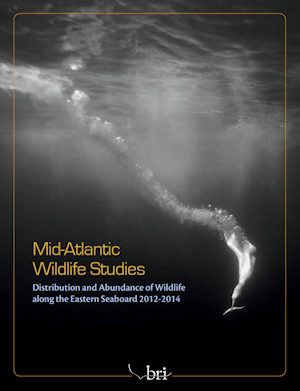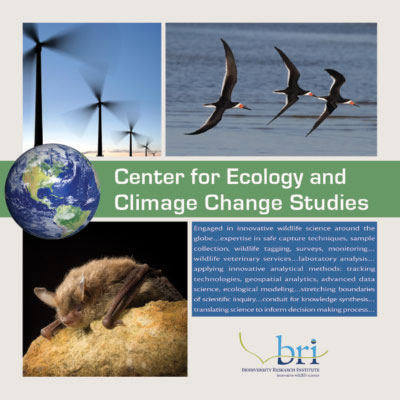Climate Change—A Pervasive Threat to Nature and People.
More than ever, sound science is needed to increase our understanding of the challenges that climate change raises for humanity. BRI believes that with good information, people can make appropriate decisions.
Collective Research Empowers Deeper Understanding
Improving Information Necessary for Environmentally Sound Renewable Energy Decisions

Renewable energy has become a primary means of addressing climate change. BRI established its Wildlife and Renewable Energy Program a decade ago, continues to be a powerful resource for assessing the impacts of renewable energy on wildlife. Careful siting of renewable energy development can play a key role in minimizing impacts to wildlife, and this requires detailed knowledge of a given species’ migratory movements, habitat needs, and other life history information.
BRI continues to provide critical information on wildlife necessary to make the most informed decisions to support environmentally-sound renewable energy decisions. To better understand how BRI carries out this work, see our work on offshore wind in New York, in the Great Lakes, and in the Mid-Atlantic.
BRI uses the latest advances in technology to obtain the most relevant information, such as high-definition imaging to monitor large areas of the ocean, and using new quantitative lab methods to assess predator-prey relationships. We are actively engaged in similar assessments of solar energy and hydroelectric energy.
Please see a recent example of BRI’s research on Assessing Cumulative Exposure of Northern Gannets to Offshore Wind Farms to better understand our work.
Conducting Long-term Collaborative Studies to Understand Wildlife Responses to Climate Change

To view climate change through the lens of wildlife, long-term studies are of great importance because the longer the temporal scope of a study, the better we can discern changes over time. Unfortunately, long-term studies on wildlife are rare. The few, and critical, ongoing studies give us important insights that shorter-term studies cannot. Examples of BRI’s commitment to long-term studies, through collaboration and persistence, are highlighted, below.
- BRI’s Loon Program—The hallmark of BRI’s work, this program has been studying loon species across the Northern Hemisphere for three decades. The research includes exciting new successful loon restoration efforts that increases the loons’ ability to persist in a climate-changing world.
- BRI’s Arctic Program—In the face of climate change, the conservation of Arctic ecosystems is one of the greatest ecological and political challenges of our time. BRI has established an Arctic Program to contribute to this effort through participation in collaborative research and conservation initiatives designed to identify new and emerging stressors and to inform stakeholders and policymakers about our science.
- Tracking Wildlife—Some of the most pronounced responses of wildlife to climate change can be seen in the changes to their traditional movement patterns. BRI has been involved in cutting-edge research to understand these complicated impacts including:
- Multiple Species (animal movement in the Arctic); Marine Birds (Northern Gannets, American Common Eiders and migratory sea ducks); Loons (Red-throated Loons) and Raptors (Migrant raptors along the Atlantic Flyway )
- Supporters, Collaborators, and Affiliations—It is only through the breadth, depth, and strength of our network that BRI can accomplish its goals, particularly in sustaining long-term studies that are expensive and difficult to sustain over time.
Understanding Environmental Stressors and the Sensitivity of Ecosystems to Climate Change

One way BRI works to better to understand the sensitivity of ecosystems to climate change is by investigating how ecosystems are impacted by other environmental stressors over time.
Environmental stressors include biological (pathogens such as bacteria and fungi that cause disease), physical (human development), and chemical (pollutants).
BRI has spearheaded multiple efforts to study the impacts of these stressors, including:
- Uncovering the impacts of global mercury contamination to wildlife: BRI is a global leader in understanding the impacts of mercury contamination to wildlife. For example, through its efforts to support the UN Minamata Convention on Mercury, it has established the only global database on mercury impacts to wildlife
- Highlighting the importance of restoration and reintroduction: In order to address decades of contamination and loss of range for the Common Loon in the Northeast United States, BRI launched an ambitious reintroduction effort that will help to restore the call of the loon.
- Discovering critical insights from sensitive sentinel species: Through extensive and prolonged collaborative research efforts, BRI has lead the way to discovering the critical importance of songbirds as sensitive sentinel species that help us understand the complexities of food webs, which leads us to understand the impact of mercury on ecosystems.
Providing Cutting-edge Science to Inform Societal Decisions about Climate Change

BRI has invested in building sound and diverse science capacity that harnesses the latest in cutting-edge tools and methods needed for understanding climate change impacts to wildlife.
For examples of BRI’s robust science capacity, have a look at some of our ecological modeling efforts and use of new technology to generate comprehensive ecological assessments.
The impacts of climate change are evident in ecosystems from pole to pole – tropical to arctic. BRI’s overarching Research Centers, and the array of programs carried out under them, provide broad-reaching research resources and capabilities to study climate change.
For more information on each of our Research Centers, follow these links.
Photo Credits: Header photo © Shutterstock – Ginger Polina Bublik; Wind turbines © iStock; Peregrine Falcon with Backpack © BRI – Alex Dalton; Common Loon on nest with chick © Bill Hanson; Special Section: African Lion by billybruce2000-shutterstock.



